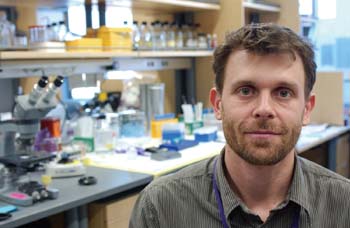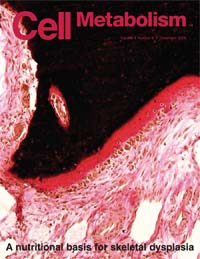
Florent Elefteriou, Ph.D., is studying nutrition’s impact on bone formation.
Photo by Susan Urmy
Nutrition found to impact bone formation: study

Scientists in the new Vanderbilt Center for Bone Biology have found a surprising connection between nutrition and skeletal development.
The investigators report in the December issue of Cell Metabolism that manipulation of dietary protein levels can reverse and even prevent skeletal defects in a mouse model of a human genetic disease.
Florent Elefteriou, Ph.D., assistant professor of Medicine, and colleagues in Texas and New York were interested in understanding why patients with a disease called neurofibromatosis have skeletal defects.
Neurofibromatosis type 1, which results from mutations in the gene NF1, causes tumors in the nervous system, learning deficits and skeletal abnormalities including low bone mineral density, scoliosis and bowing of long bones followed by pseudoarthrosis — a false joint created when bones fail to fuse after a fracture.
“This failure in fracture healing is a very serious problem for these patients, who cannot walk as a result and often require amputation,” Elefteriou said.
To probe how neurofibromatosis affects bone formation, the investigators created a mouse model for the skeletal aspects of the disease. Mice that lack the NF1 gene in every cell (NF1 knockout mice) die during fetal development, before the skeleton is well-formed.
So the team deleted the NF1 gene only in osteoblasts, the specialized cells that build bone by secreting the structural protein collagen.
Mice missing the NF1 gene in osteoblasts began to develop skeletal abnormalities after birth, including both increased bone formation and increased bone resorption (bone-destroying activity), resulting in an overall increase in bone mass. This was a surprise, Elefteriou said, because patients with neurofibromatosis have low bone mass.
But the thicker bone structures in the mice were not mature bone, the researchers found. Instead, the extra material was excess collagen that had not been mineralized (the addition of calcium and minerals to the collagen matrix, creating hard mature bone).
“The main job of osteoblasts is to secrete collagen; that's what they do for a living,” Elefteriou said. “But in this disease, when they don't have NF1, they secrete much more than usual, and you see a build-up of non-calcified collagenous matrix.”
The investigators then explored the signaling mechanisms in osteoblasts to understand what happens at the cellular level in the absence of NF1, Elefteriou said. Using cell signaling studies, gene expression studies, and published data, the scientists were able to put together a linear signaling pathway connecting NF1 to the target gene ATF4. ATF4 was known to be important for collagen synthesis and osteoblast differentiation.
“This is the first target gene of NF1 that has been identified in osteoblasts,” Elefteriou said.
The high bone mass in mice with NF1-deficient osteoblasts was the mirror image of the low bone mass observed in mice lacking the ATF4 gene — findings published by another new member of the Vanderbilt Center for Bone Biology, Xiangli Yang, Ph.D., assistant professor of Medicine. Together, the previous and current studies suggest that NF1 signaling limits ATF4 activity. In the absence of NF1, ATF4 is overactive, leading to increased collagen production.
The first hint that nutrition could be important to bone cell function came from studies of ATF4-deficient osteoblasts growing in cell culture. ATF4-deficient cells do not mature as readily as normal osteoblasts, but most importantly, they produce less collagen because they cannot acquire enough of the raw materials to build it. The researchers discovered that simply adding amino acids (the building blocks of proteins and of collagen) to the culture swill could rescue these abnormalities.
“You can bypass the ATF4 deficiency in culture by basically stuffing the cells with amino acids,” Elefteriou said. “We wondered if proteins could be used to correct a skeletal defect in the mice in vivo.”
The answer was a surprising yes.
The investigators fed the mice with NF1-deficient osteoblasts — that overproduce collagen — a low protein diet, and normalized bone formation. The opposite strategy worked in the ATF4-deficient mice with low bone mass: a high protein diet increased the bone mass to normal levels.
“This was really quite surprising, that diet could have such an impact on skeletal development,” Elefteriou said. He cautions that the dietary rescue of skeletal mass currently applies only to these mouse models with ATF4-related defects. Normal mice eating a high or low protein diet showed no skeletal changes.
The implications are tantalizing, Elefteriou said, but the complexity of this disease will require additional mouse models and efforts to understand its variability and the molecular mechanisms leading to it.
“Our work clearly demonstrates that using and sharing the genetic tools available today can be very fruitful not only to characterize new signaling pathways and target genes, but also to test original therapeutic avenues based on this new knowledge,” he said.
“Any contribution that could be made by dietary manipulations to management of a genetic disorder would indeed be of remarkable novelty and interest,” wrote T. John Martin, M.D., of St. Vincent's Institute and the University of Melbourne, in a preview commentary in Cell Metabolism.
The research was supported by the National Institutes of Health and The Children's Tumor Foundation.













